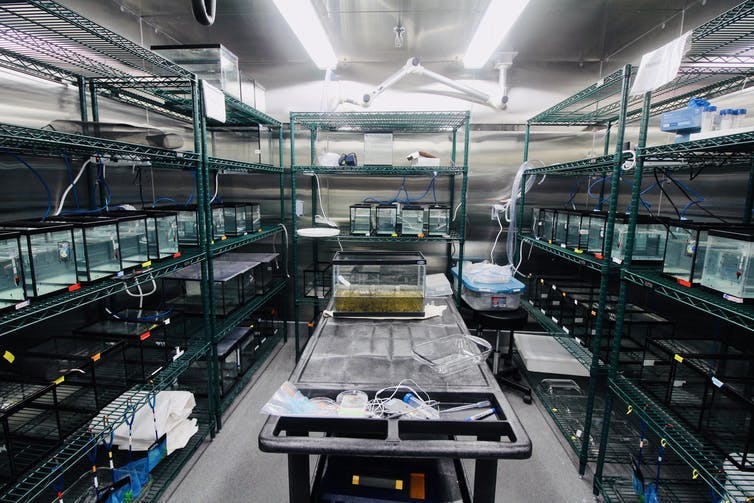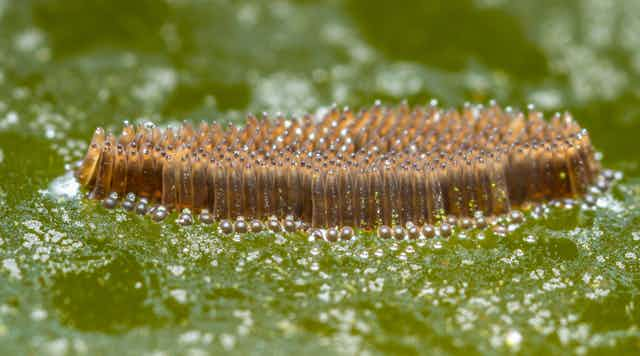The question of how pesticides affect public health and the environment has generated a lot of attention in Québec. Pesticides are widely used and often end up in our natural environment.
Pesticides are useful for killing weeds (herbicides), fungi (fungicides), insect pests in agriculture and fleas in pets (insecticides). They are also used to reduce the numbers of biting insects in urban and rural environments.
We have recently studied the indirect health effects on frogs of a biopesticide that has been in use for several decades, mainly to reduce the number of bothersome mosquitoes.
Bacterial proteins are naturally occurring insecticides
Bti is one of a number of pesticides used worldwide to reduce the populations of biting insects that breed in wetlands. This biological insecticide is composed of natural toxins from the bacterium Bacillus thuringiensis israelensis.
These toxins, synthesized in the form of crystals, belong to the Cry family of proteins, and target the larvae of biting insects such as mosquitos and blackflies. After the larvae ingests the crystals, they dissolve in the digestive tract and are transformed into toxic proteins that destroy the walls of the intestine, killing the larvae.
In principle, Cry toxins should not affect the intestinal walls of vertebrate species (mammals, birds, reptiles, amphibians and fish) because the digestive conditions of these species do not favour the transformation of the crystals into destructive proteins. According to Health Canada Bti is not a high risk to other animals and humans.
However, the use of Bti remains controversial.
Toxic effects or no effects of Bti formulations?
Bti is often applied directly to small bodies of water, such as marshes, to specifically target aquatic mosquito and blackfly larvae. It could potentially impact other aquatic animal species, such as frog tadpoles, which are known to be sensitive to pollutants.
Some studies have shown that Bti formulations can be directly toxic to frogs, while others have revealed no effects.
For example, two Argentinian studies reported that a commercial formulation of Bti, called Introban, was toxic to tadpoles of the Creole frog. However, our work showed that a Bti formulation called VectoBac did not cause mortality in wood frog and American toad tadpoles.

These contrasting results could be attributed to the different Bti formulations used in one country or another, the product’s potency, the species used or the environmental conditions during the experiments. Each commercial Bti product also contains additives that are known only to their manufacturers and whose effects on tadpoles are not known.
Our team has written about these differences in an article published in the scientific journal Archives of Environmental Contamination and Toxicology.
Metamorphosis and intestinal microbiota
The results of our study, published recently in the journal Environmental Science & Technology, revealed that VectoBac may affect frog metamorphosis — the transition from tadpole to young frog.
In wood frogs and American toads, two types of VectoBac altered the time it took a tadpole to metamorphose, either delaying metamorphosis by nearly five days or advancing it by one day, depending on the treatment. Studies on frog ecology have established that early metamorphosis reduces a frog’s chance of survival, which could ultimately reduce population sizes.
In addition to metamorphosis, both types of VectoBac we studied altered the composition of the gut bacterial community of exposed young toads. Indeed, with the application rates recommended by the manufacturer, there was an increase in the relative abundance of certain families of gut bacteria. The impact of these changes remains unknown.
A 2017 study by Jason Rohr of the University of Pittsburgh showed that disruption of the microbiota of amphibians decreases resistance to parasites later in life. Our team will focus on determining whether Bti-induced changes in microbiota impact the physiology of frogs in the long-term.
The precautionary principle
Should the precautionary principle, which states that “a substance should be considered potentially harmful to human health and the environment until proven otherwise,” be applied to amphibian habitats?
Our results indicate that the impact of commercial Bti products on amphibian health is variable among the species we studied, but our understanding remains limited. Bti formulations contain ingredients other than just natural toxins and we do not yet know if these have any effects on tadpoles.
As a result, we recommend that the application of Bti products in amphibian-rich ecosystems be targeted and minimized, taking into account sensitive periods during a frog’s life cycle, including reproduction and development of eggs into young frogs.
These precautions should be applied until research is conducted to assess whether the observed changes in metamorphosis and gut microbiota have adverse effects on amphibian populations.


